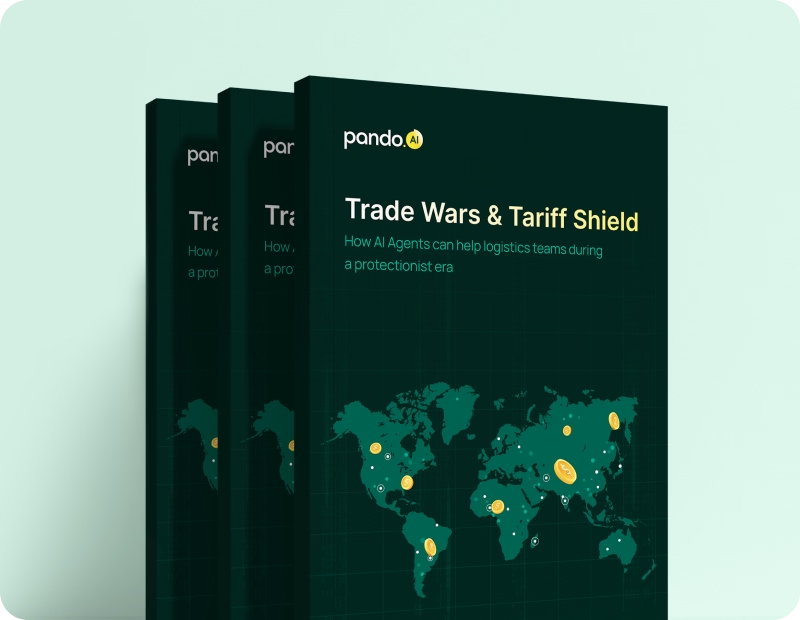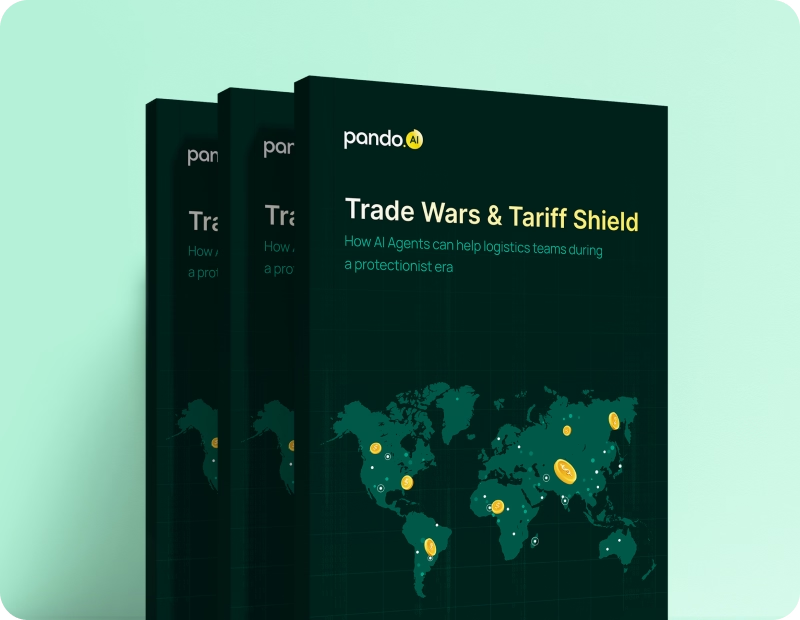-
Products Products
- Industry
- Initiatives
- Resources
- Company
- Book a demo

Before you go: Logistics leaders just dropped the truth on AI
The State of AI in Logistics 2025 is here — no hype, just real conversations and raw insights.
Strategic freight sourcing in volatile market conditions: How to navigate uncertainty and secure competitive rates
Securing competitive freight rates in volatile markets through smart sourcing strategies.
Published on December 9, 2024 • 6 mins read
Rohit Lakshman

Securing competitive freight rates in volatile markets through smart sourcing strategies.
Businesses are finding it challenging to secure competitive shipping rates due to geopolitical conflicts, economic uncertainties, and constant interruptions in supply chains. This is prompting companies to adopt strategic sourcing strategies for freight services.
Top 3 reasons for freight rate volatility
Freight rates have been highly volatile of late, often mirroring current market sentiment. These rates can be influenced by a variety of international events, including political developments and natural disasters. Key factors affecting freight rates include:
Geopolitical elements: Trade conflicts and tariffs
Geographic conflict is one of the primary reasons for market instability in freight sourcing. Trade wars have led to high tariffs, particularly among large economies. This has adversely affected the flow of goods across the globe.
Such conflicts raise import and export costs, making freight rates more erratic. Ambiguity in trade agreements can cause supply chain disruption. Therefore, businesses must reroute shipments or seek new suppliers; however, this may lead to a rise in transportation costs.
Economic fluctuations
Global economic factors such as inflation, devaluation of currencies, and shifting interest rates impact freight sourcing. A sluggish economy sometimes results in weaker consumer demand, which adversely affects transportation volumes.
However, freight rates may surge during times of economic recovery due to rising demand for transportation. Furthermore, fuel price fluctuations directly influence freight market volatility.
Supply chain interruptions
Natural disasters, labor strikes, and the COVID-19 epidemic have led to supply chain disruptions, complicating freight cost predictions. Such interruptions cause delays, congestion at ports, and higher demand for some transportation services, thus raising freight pricing.
The scarcity of accessible carriers during these periods can also result in more competition for capacity, further driving price inflation.
Strategies to mitigate market volatility and navigate uncertainty
In an uncertain logistics landscape, businesses need to implement strategies that facilitate mitigation of risks and effective management of customer deliveries. Here are some noteworthy strategies for businesses to adopt:
1. Utilizing the rate manager tool
A rate management tool is a sound strategic investment for securing a competitive freight cost. It is particularly useful in the following situations:
- When market volatility is high, rate increases by carriers are anticipated.
- When shippers are operating on tight budgets, minimizing shipping costs is essential for maintaining profitability.
- When carriers are interested in working with companies that can consistently maintain a steady shipment capacity or volume.
A customized rate management tool can digitize and version control all of your contracts and rates in a structured way. This will allow you to keep track of any changes made to the rates.
Pando makes it easy to handle complex accessorial charges, both general and mode-specific, by providing a straightforward low code/no code option for managing the definition and calculations of accessorial costs against your freight contracts.
2. Extensive scenario modeling
It enables effective navigation through market volatility. By evaluating factors such as expenses, allocation limits, and favored carriers, businesses can develop a range of sourcing scenarios.
This empowers them to pinpoint the most economical and dependable choices across various market scenarios, guaranteeing adaptability and strength in their sourcing approaches.
3. Tailored negotiation levers
Businesses can customize their negotiation strategies by evaluating elements such as lane bundles, prevailing market conditions, and the equilibrium between spot and long-term contracts.
This strategy allows them to obtain advantageous rates, foster robust carrier partnerships, and respond effectively to market changes, guaranteeing reliable and economical freight sourcing.
4. Unified data platform for competitive freight rate
Businesses can access, compare, and evaluate rates across carriers and modes of transportation quickly using unified supply chain management platforms such as Pando.ai.
This advanced platform provides a control tower view from which you can oversee all quotation performance requirements, thereby improving accuracy, speed-to-market, and the quality of quotation and rating judgments.
5. Staying informed and analyzing market trends
As the freight industry becomes increasingly competitive, it's crucial to identify and capitalize on every potential cost-saving opportunity while delivering exceptional service to customers.
Every day, new solutions are penetrating the market; some of them are acting as changemakers in the industry. Companies are leveraging advanced analytics to better understand market trends, demand forecasts, and shipping choice optimization.
Data-driven analytics can facilitate the early identification of capacity issues, tracking freight rate patterns, and prediction of market fluctuations.
6. Embracing automation and technology
Automation tools simplify processes such as load matching, carrier selection, and route optimization. This reduces costs, boosts operational efficiency, and decreases human errors during volatile market conditions. Automated systems are becoming increasingly important as companies are striving to improve their market-shift responsiveness.
According to the Council of Supply Chain Management Professionals, the majority of 3PLs (96%) and shippers (86%) are investing in predictive analytics and other tools to make the most of data collected from the Internet of Things (IoT).
7. Building strong partnerships and collaborations
Long-term partnership with carriers guarantees consistent capacity and better rate negotiations. Furthermore, strong business relationship with logistics partners promotes service quality and priority access during peak times.
Collaborative efforts with freight partners, such as those during long-term contract negotiations, provide carriers with stable business. Thus, businesses can experience flexibility in pricing in response to market changes.
The importance of carrier pool diversification
Steering through the unpredictable freight market presents its challenges, yet diversifying your carrier pool stands out as a smart strategy to reduce risk and manage uncertainty. Discover the significance behind it:
- Adaptability: With a variety of carriers at your disposal, you can swiftly respond to market shifts, guaranteeing that your products are consistently on the move.
- Maximize Your Budget: Explore the diverse rates offered by various carriers. Diversifying allows you to select the most budget-friendly choices, ultimately leading to significant savings over time.
- Reliability: Counting on just one carrier can pose risks if they encounter delays or problems. A varied selection guarantees that you’re never without a safety net.
- Service variety: Explore the diverse offerings of various carriers, each bringing unique strengths to the table, whether it’s specialized routes or expertise in handling specific types of cargo. This selection elevates your service quality to new heights.
Strategically diversifying your carrier pool allows you to navigate market fluctuations while ensuring smooth and efficient operations adeptly. This strategy actively safeguards stability in a volatile industry.
Companies successfully navigating volatile markets through strategic freight sourcing
The following businesses are effectively navigating erratic market conditions through strategic sourcing processes:
Walmart
Walmart, one of the biggest retailers in the world, employed advanced supply chain analytics and blockchain technology in 2019 to track shrimp from the time they are caught in Andhra Pradesh all the way to certain Sam's Club stores in the U.S. The use of Blockchain technology in the supply chain to trace shrimp shipments from domestic farms to international merchants was a first of its kind.
Apple
Apple employs a range of transportation methods, such as ground transportation, air freight, and sea freight, to move its supplies and goods. The company additionally makes use of logistics providers and third-party logistics (3PL) firms to further facilitate the management and coordination of product and material movement.
Unilever
Unilever successfully generated significant benefits through advanced freight solutions that combine software, professional services, and domain expertise.
Some areas of benefits include:
- Truckload
- Less-than-truckload (LTL)
- Intermodal
- Ocean
- Small parcel
Partner with Pando.ai for scalable supply chain solutions
Businesses need to be flexible enough to respond to shifting market conditions, quick enough to grab opportunities, and cautious enough to avoid potential pitfalls during market volatility.
Businesses can make informed decisions by collaborating with Pando.ai, which provides agile supply chain solutions powered by cutting-edge technologies. Pando.ai can also plug into your evolving IT infrastructure, offer scalability, and provide rapid value realization.
For more information, check out Pando's resource page.
Subscribe to Pando blog and Crossroads newsletter now!
Stay up to date with the latest logistics, transportation, and supply chain tips and news.
Subscribe Here!













